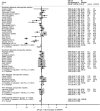Does milk intake promote prostate cancer initiation or progression via effects on insulin-like growth factors (IGFs)? A systematic review and meta-analysis
- PMID: 28361446
- PMCID: PMC5400803
- DOI: 10.1007/s10552-017-0883-1
Does milk intake promote prostate cancer initiation or progression via effects on insulin-like growth factors (IGFs)? A systematic review and meta-analysis
Abstract
Purpose: To establish whether the association between milk intake and prostate cancer operates via the insulin-like growth factor (IGF) pathway (including IGF-I, IGF-II, IGFBP-1, IGFBP-2, and IGFBP-3).
Methods: Systematic review, collating data from all relevant studies examining associations of milk with IGF, and those examining associations of IGF with prostate cancer risk and progression. Data were extracted from experimental and observational studies conducted in either humans or animals, and analyzed using meta-analysis where possible, with summary data presented otherwise.
Results: One hundred and seventy-two studies met the inclusion criteria: 31 examining the milk-IGF relationship; 132 examining the IGF-prostate cancer relationship in humans; and 10 animal studies examining the IGF-prostate cancer relationship. There was moderate evidence that circulating IGF-I and IGFBP-3 increase with milk (and dairy protein) intake (an estimated standardized effect size of 0.10 SD increase in IGF-I and 0.05 SD in IGFBP-3 per 1 SD increase in milk intake). There was moderate evidence that prostate cancer risk increased with IGF-I (Random effects meta-analysis OR per SD increase in IGF-I 1.09; 95% CI 1.03, 1.16; n = 51 studies) and decreased with IGFBP-3 (OR 0.90; 0.83, 0.98; n = 39 studies), but not with other growth factors. The IGFBP-3 -202A/C single nucleotide polymorphism was positively associated with prostate cancer (pooled OR for A/C vs. AA = 1.22; 95% CI 0.84, 1.79; OR for C/C vs. AA = 1.51; 1.03, 2.21, n = 8 studies). No strong associations were observed for IGF-II, IGFBP-1 or IGFBP-2 with either milk intake or prostate cancer risk. There was little consistency within the data extracted from the small number of animal studies. There was additional evidence to suggest that the suppression of IGF-II can reduce tumor size, and contradictory evidence with regards to the effect of IGFBP-3 suppression on tumor progression.
Conclusion: IGF-I is a potential mechanism underlying the observed associations between milk intake and prostate cancer risk.
Keywords: Insulin-like growth factors; Mechanistic pathway; Meta-analysis; Milk; Prostate cancer; Systematic review.
Figures





Similar articles
-
Serum Insulin-Like Growth Factor Axis and the Risk of Pancreatic Cancer: Systematic Review and Meta-Analysis.Nutrients. 2017 Apr 18;9(4):394. doi: 10.3390/nu9040394. Nutrients. 2017. PMID: 28420208 Free PMC article.
-
Circulating insulin-like growth factor peptides and prostate cancer risk: a systematic review and meta-analysis.Int J Cancer. 2009 May 15;124(10):2416-29. doi: 10.1002/ijc.24202. Int J Cancer. 2009. PMID: 19142965 Free PMC article.
-
The associations of anthropometric, behavioural and sociodemographic factors with circulating concentrations of IGF-I, IGF-II, IGFBP-1, IGFBP-2 and IGFBP-3 in a pooled analysis of 16,024 men from 22 studies.Int J Cancer. 2019 Dec 15;145(12):3244-3256. doi: 10.1002/ijc.32276. Epub 2019 Apr 4. Int J Cancer. 2019. PMID: 30873591 Free PMC article.
-
Effect of lycopene on insulin-like growth factor-I, IGF binding protein-3 and IGF type-I receptor in prostate cancer cells.J Cancer Res Clin Oncol. 2007 Jun;133(6):351-9. doi: 10.1007/s00432-006-0177-6. Epub 2007 Jan 12. J Cancer Res Clin Oncol. 2007. PMID: 17219202 Free PMC article.
-
IGFBP-1 and IGF-I in relation to adiposity and mortality from midlife to old age in the Swedish Adoption/Twin Study of Aging.Int J Obes (Lond). 2025 Jul;49(7):1327-1333. doi: 10.1038/s41366-025-01773-x. Epub 2025 Apr 5. Int J Obes (Lond). 2025. PMID: 40188287 Free PMC article.
Cited by
-
Connecting the Dots Between the Gut-IGF-1-Prostate Axis: A Role of IGF-1 in Prostate Carcinogenesis.Front Endocrinol (Lausanne). 2022 Mar 15;13:852382. doi: 10.3389/fendo.2022.852382. eCollection 2022. Front Endocrinol (Lausanne). 2022. PMID: 35370981 Free PMC article. Review.
-
Dairy consumption and risks of total and site-specific cancers in Chinese adults: an 11-year prospective study of 0.5 million people.BMC Med. 2022 May 6;20(1):134. doi: 10.1186/s12916-022-02330-3. BMC Med. 2022. PMID: 35513801 Free PMC article.
-
Dairy consumption and hepatocellular carcinoma risk.Ann Transl Med. 2021 Apr;9(8):736. doi: 10.21037/atm-2020-ubih-06. Ann Transl Med. 2021. PMID: 33987434 Free PMC article. Review.
-
Genetically proxied milk consumption and risk of colorectal, bladder, breast, and prostate cancer: a two-sample Mendelian randomization study.BMC Med. 2020 Dec 2;18(1):370. doi: 10.1186/s12916-020-01839-9. BMC Med. 2020. PMID: 33261611 Free PMC article.
-
Potential Protective Protein Components of Cow's Milk against Certain Tumor Entities.Nutrients. 2021 Jun 8;13(6):1974. doi: 10.3390/nu13061974. Nutrients. 2021. PMID: 34201342 Free PMC article. Review.
References
-
- World Cancer Research Fund International/American Institute for Cancer Research Continuous Update Project Report: Diet, Nutrition, Physical Activity, and Prostate Cancer, available at: [http://www.wcrf.org/sites/default/files/Prostate-Cancer-2014-Report.pdf]
Publication types
MeSH terms
Substances
Grants and funding
LinkOut - more resources
Full Text Sources
Other Literature Sources
Medical
Miscellaneous

